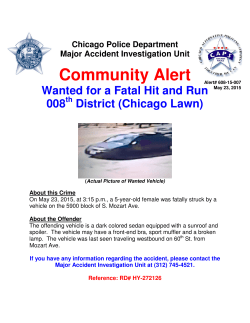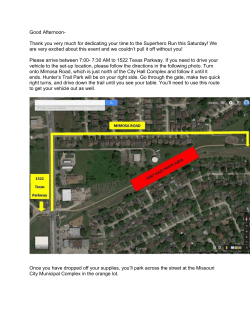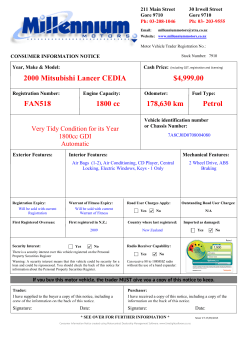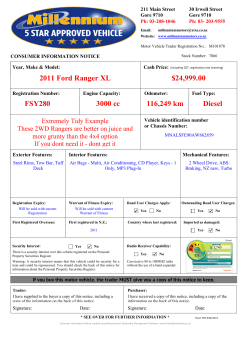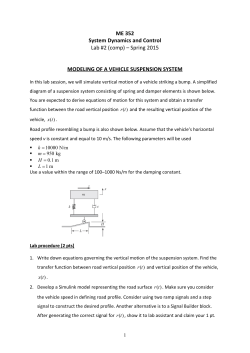
list of frequently asked questions
FAQ List on Changes to Rigid & Drawbar Trailer Weight Limits The Introduction of the 46 tonne national weight limit for six (or more) axle rigid and drawbar trailer combinations 1. What vehicle types are in scope of this weight increase? 2. When do these new regulations come into force? 3. Where can I obtain a copy of the new Regulations? 4. What specific technical features must rigid and drawbar trailer combinations be equipped with for 46 tonne operation? 5. Why don’t rigid trucks having more than 3 axles require ESC? 6. What if the distance between the rearmost axle of my towing vehicle and the foremost axle of my trailer is less than 3 metres? Can I extend the drawbar to 3 metres and operate at 46 tonnes? 7. Why are ABS equipped rigid vehicles and trailers not suitable for 46 tonne operation? 8. My rigid vehicle is EBS equipped but my drawbar trailer is not. Can I upgrade my trailer to EBS to enable me to operate at 46 tonnes? 9. What does “Design Gross Vehicle Weight” (DGVW) mean? 10. What does “Gross Combination Weight” mean? 11. What does the “National Weight Limit” mean? 12. What does “Appropriate Motor Vehicle” mean? 13. What do the terms ‘already in service’, ‘first registered’ & ‘first licensed’ mean? 14. I purchased a second hand drawbar trailer (which I plan on running as part of a 46 tonne combination) in another country but have not yet licensed it with my local motor tax office. How will the new regulations affect me? 15. Do they apply in Northern Ireland & the UK? 16. Do rigid vehicles have to adhere to specific tonnes/metre requirements, and if so what are they? 17. Do drawbar trailers have to adhere to specific tonnes/metre requirements, and if so what are they? 19. Is there a penalty for breach of national vehicle weight limits? 20. I have a 6 axle rigid truck and drawbar trailer combination. What do I have to do to operate at 46 tonnes? 21. Do I need to re-plate my trailer to operate at 46 tonnes? 22. A haulage firm carries out deliveries for my company. What assurance do I need that the operator’s vehicles are fitted with the necessary features to operate at 46 tonnes? 23. Where can I find contact details for the responsible people at the original vehicle manufacturers / their authorised Irish distributors who will stamp and sign the ’46 tonne Declaration of Conformity’? This FAQ document is intended as a general guide for industry, hauliers and interested members of the public. It is not an interpretation of the law. April 2015 24. Where can I find an NSAI Authorised Plating Centre? 25. What types of vehicles need to be fitted with an authorisation plate (i.e. a national weights and dimensions plate)? 26. If my vehicle is modified or altered, do I have to change the weights and dimensions plate? 27. What if I’m taking my modified vehicle to a plating centre? 28. What is the penalty for operating a vehicle in a public place without an authorisation plate fitted where required? 29. I want to fit an additional axle to an existing two axle rigid truck to be able to operate at the 46 tonne combination weight, is this possible? 30. I had my vehicle re-plated for 46 tonne operation but now need some of the data contained on my Vehicle’s Registration Certificate (VRC) updated, what should I do? 31. I have retrofitted a third axle to my truck and its unladen weight has increased? Do I need to notify my local Motor Tax office? 32. Where can I find more information if I need it? This FAQ document is intended as a general guide for industry, hauliers and interested members of the public. It is not an interpretation of the law. April 2015 1. What vehicle types are in scope of this weight increase? The weight increase applies to six (or more) axle rigid vehicle and drawbar trailer combinations. However the rigid vehicle element of the combination must be an ‘appropriate motor vehicle’, i.e. it must have a minimum of three axles. Therefore, subject to the vehicles being capable by design and satisfying the necessary qualifying technical criteria, and provided the distance between the rearmost axle of the rigid vehicle and the foremost axle of the drawbar trailer is 3 metres or greater, the weight increase applies to 3+3, 3+4, 4+2, 4+3 or 4+4 combinations etc. Refer to the illustrations below of the most popular rigid vehicle and drawbar trailer combinations. 2. When do these new regulations come into force? The new Regulations take effect from 1 June 2015. 3. Where can I obtain a copy of the new Regulations? The new regulations are titled the Road Traffic (Construction and Use of Vehicles) (Amendment) Regulations 2015 (S.I. No. 136 of 2015), amending the Road Traffic (Construction and Use of Vehicles) Regulations 2003 (S.I. No. 5 of 2003), otherwise known as the ‘C&U’ Regulations. Double click on the embedded links above to open. 4. What specific technical features must rigid and drawbar trailer combinations be equipped with for 46 tonne operation? A summary of the qualifying criteria necessary for 46 tonne operation is as follows: This FAQ document is intended as a general guide for industry, hauliers and interested members of the public. It is not an interpretation of the law. April 2015 1. Rigid vehicles and drawbar trailers already in service prior to 1 June 2015 will require air suspension or equivalent systems1 and Electronic Braking Systems (EBS). Anti-lock Braking Systems (ABS) are not sufficient. 2. New rigid vehicles registered on or after 1 June 2015, will in addition to requiring air suspension or equivalent systems and EBS, also require Electronic Stability Control (ESC). However an exemption from the ESC requirement is provided for rigid vehicles having more than 3 axles. 3. New drawbar trailers licensed on or after 1 June 2015, will in addition to requiring air suspension or equivalent systems and EBS, also require Roll Stability Control (RSC). 4. The distance between the rearmost axle of the towing vehicle and the foremost axle of the trailer must be 3 meters or greater to operate at a gross combination weight of 46 tonnes. 5. Why don’t rigid trucks having more than 3 axles require ESC? Category N3 vehicles (i.e. goods vehicles with a Design Gross Vehicle Weight (DGVW) exceeding 12 tonnes) having more than 3 axles are generally used in ‘off-road’ applications. Under type approval such vehicles do not require ESC as it is incompatible with their use in ‘off-road’ environments, coupled with the fact that such vehicles are inherently more stable due to the additional number of wheels in contact with the surface of the road. 6. What if the distance between the rearmost axle of my towing vehicle and the foremost axle of my trailer is less than 3 metres? Can I extend the drawbar to 3 metres and operate at 46 tonnes? Yes provided the trailer is capable by design and is equipped with the necessary technical features for 46 tonne operation; and furthermore that any modifications carried out are certified by the trailer manufacturer or their authorised Irish distributor, an authorised representative of an Approved Test Centre (ATC)2 or a Suitably Qualified Individual (SQI)3. The trailer will also require re-plating at an NSAI authorised plating centre. 7. Why are ABS equipped rigid vehicles and trailers not suitable for 46 tonne operation? Electronic Braking System (EBS) uses electronic controls to improve vehicle control, reaction and stability during braking over and above that currently possible from a conventional ABS system. This is achieved by using electrical signals to operate pneumatic valves, with a back-up ABS system being retained in case of an electrical failure. The greatest benefit of EBS systems is that they can simultaneously fulfil the operation of an anti-lock braking system and a load sensing system with a superior reaction time. It is for this reason (in terms of minimising the road safety risk associated with operating at higher weights) that EBS is mandated for 46 tonne operation. 1 Equivalent suspension systems means a suspension system which fulfils the conditions for equivalence to air suspension as set out in Annex II to Council Directive 96/53/EC. Consult the vehicle manufacturer or their authorised Irish distributor for further information. 2 http://www.nsai.ie/Our-Services/Certification/Automotive-Certification/Type-Approval/Approved-Test-Centers.aspx 3 A Suitably Qualified Individual (SQI) must have: an Engineering/Technical Qualification (Level 7 or higher accredited courses) or appropriate accreditation with Engineers Ireland (or the Institute of Automobile Engineer Assessors a minimum of 5 years experience of working in a suitable technical environment (preferably Automotive or Engineering Environment) access to adequate facilities to carry out a thorough vehicle examination, and appropriate professional indemnity insurance. This FAQ document is intended as a general guide for industry, hauliers and interested members of the public. It is not an interpretation of the law. April 2015 8. My rigid vehicle is EBS equipped but my drawbar trailer is not. Can I upgrade my trailer to EBS to enable me to operate at 46 tonnes? Yes and you should contact the original trailer manufacturer or the authorised distributor to carry out the necessary modification for you. However if the original manufacturer is no longer in business, we recommend that you contact another manufacturer or their authorised agent to examine the trailer for you and determine what needs to be done to achieve compliance for 46 tonne operation. They should also be able to provide you with an estimate of how much the upgrade might cost. 9. What does “Design Gross Vehicle Weight” (DGVW) mean? Design Gross Vehicle Weight (DGVW) means the gross weight of a vehicle laden with the heaviest load which it can reasonably carry. This must take into consideration; the engine, brakes, tyres and general construction of such vehicle and shall, until the contrary is shown, be taken to be its design gross weight as specified by its manufacturer or an automotive engineer. 10. What does “Gross Combination Weight” mean? Gross Combination Weight is the weight of the rigid vehicle and drawbar trailer, including the load being carried on each. 11. What does the “National Weight Limit” mean? To protect Ireland’s road and bridge infrastructure, goods vehicles (and their trailers) with a DGVW exceeding 3,500kg must adhere to predefined maximum permitted weights and dimensions for use on roads in Ireland. These are outlined in a leaflet that we have prepared for the guidance of industry, hauliers and interested members of the public, a copy of which can be downloaded here. 12. What does “Appropriate Motor Vehicle” mean? "Appropriate motor vehicle" means a mechanically propelled vehicle having at least three axles, twin tyres, air suspension or an equivalent suspension on each driving axle and ABS brakes. The vehicle must also be fitted with an authorisation plate (i.e. a national weights & dimensions plate) in the format illustrated on page 14 of the HCV Manual. 13. What do the terms ‘already in service’, ‘first registered’ & ‘first licensed’ mean? ‘Already in service’ means a rigid vehicle that has been registered with the Revenue Commissioners or a drawbar trailer that has been licensed with the Local Authority Motor Tax Office before 1 June 2015. ‘First registered’ means the date when a rigid vehicle was first registered with the Revenue Commissioners or the date when first registered in accordance with the laws of another country. This FAQ document is intended as a general guide for industry, hauliers and interested members of the public. It is not an interpretation of the law. April 2015 ‘First licensed in Ireland’ means the date a drawbar trailer is first licensed with the Local Authority in whose functional area it is normally kept, irrespective of the original date of manufacture and irrespective of whether or not the drawbar trailer was previously registered/licensed in another country. 14. I purchased a second hand drawbar trailer (which I plan on running as part of a 46 tonne combination) in another country but have not yet licensed it with my local motor tax office. How will the new regulations affect me? It is a legal requirement that all goods trailers with a Design Gross Vehicle Weight (DGVW) exceeding 3,500kg (3.5 tonnes) are licensed with the Local Authority in whose functional area they are normally kept. Owners/operators of 2 (or more) axle drawbar trailers must ensure that if their trailer was first licensed with their Local Authority prior to 1 June 2015 (and they plan running it as part of a 46 tonne combination) that an Electronic Braking System (EBS) is fitted; and if licensed on or after 1 June 2015 (and again they plan running it as part of a 46 tonne combination) that both EBS and Roll Stability Control (RSC) are fitted. The Penalty under Section 102 of the 1961 Road Traffic Act for breach of the C&U Regulations (i.e. for not having the appropriate vehicle safety features such as EBS, ESC or RSC fitted where required) would lead to a Class C fine whereby on conviction, courts can impose a fine up to €2,500, a prison sentence or both. 15. Do they apply in Northern Ireland & the UK? No. The introduction of the 46 tonne limit is a national measure only. The European Union, via Directive 96/53/EC, sets the maximum authorised weights in international traffic. This ensures that no obstacles are created which would prevent the circulation of commercial vehicles between Member States. However Member States are entitled to set their own maximum authorised weights for domestic journeys. 16. Do rigid vehicles have to adhere to specific tonnes/metre requirements, and if so what are they? Yes. The weight laden (expressed in tonnes) of a rigid vehicle having three axles must not exceed the number obtained when the distance between the extreme front and rear axles (expressed in metres correct to one decimal place) is multiplied by 5.5. This is illustrated below. 3 AXLE RIGID TRUCKS TONNES PER METRE (X) MAXIMUM LADEN WEIGHT 5.5 tonnes 5.5 tonnes 25 tonnes 26 tonnes4 4 Provided that the vehicle is equipped with twin tyres and an air suspension system or an equivalent system on each driving axle, OR is equipped with twin tyres and 2 driving axles neither of which transmits to the surface of a road a weight in excess of 9.5 tonnes. This FAQ document is intended as a general guide for industry, hauliers and interested members of the public. It is not an interpretation of the law. April 2015 So take for example a three axle rigid vehicle with a 4.5 metre wheelbase (distance X on the illustration above) would mean that the laden weight of such a vehicle, irrespective of whether or not it is fitted with the necessary features for operation as part of a 46 tonne combination and whether or not it is operating with/without a trailer attached, could not exceed 24.75 tonnes (i.e. 4.5 metres multiplied by 5.5 tonnes/metre). Therefore the minimum wheelbase required for a rigid vehicle with three axles for operation at the 26 tonne maximum weight limit applicable to such a vehicle is 4.7 metres (i.e. 26 tonnes divided by 5.5 tonnes/metre). As regards rigid vehicles with four axles, the weight laden (expressed in tonnes) must not exceed the number obtained when the distance between the extreme front and rear axles (expressed in metres correct to one decimal place) is multiplied by 5. This is also illustrated below. 4 AXLE RIGID TRUCKS TONNES PER METRE (X) MAXIMUM LADEN WEIGHT 5.0 tonnes 5.0 tonnes 30 tonnes 32 tonnes5 So take for example a four axle rigid vehicle with a 6.0 metre wheelbase (distance X on the illustration above) would mean that the laden weight of such a vehicle, irrespective of whether or not it is fitted with the necessary features for operation as part of a 46 tonne combination and whether or not it is operating with/without a trailer attached, could not exceed 30 tonnes (i.e. 6.0 metres multiplied by 5.0 tonnes/metre). Therefore the minimum wheelbase required for a rigid vehicle with four axles for operation at the 32 tonne maximum weight limit applicable to such a vehicle is 6.4 metres (i.e. 32 tonnes divided by 5.0 tonnes/metre). 17. Do drawbar trailers have to adhere to specific tonnes/metre requirements, and if so what are they? There is no tonnes/metre requirement in force for drawbar trailers with two axles. However the following weight limits (which depend on whether the axle spacing is either less than 3.0 metres, or 3.0 metres or greater) apply. 5 Provided that the vehicle is equipped with twin tyres and an air suspension system or an equivalent system on each driving axle, OR is equipped with twin tyres and 2 driving axles neither of which transmits to the surface of a road a weight in excess of 9.5 tonnes. This FAQ document is intended as a general guide for industry, hauliers and interested members of the public. It is not an interpretation of the law. April 2015 In respect of drawbar trailers with three axles, the weight laden (expressed in tonnes) of a drawbar trailer having three axles must not exceed the number obtained when the distance between the extreme front and rear axles (expressed in metres correct to one decimal place) is multiplied by 5.5. This is illustrated below. So take for example a three axle drawbar trailer with a 4.3 metre wheelbase (distance X on the illustration above) this would mean that the laden weight of such a vehicle, irrespective of whether or not it is fitted with the necessary features for operation as part of a 46 tonne combination, could not exceed 23.65 tonnes (i.e. 4.3 metres multiplied by 5.5 tonnes/metre). Therefore the minimum wheelbase required for a drawbar trailer with three axles for operation at the 25 tonne maximum weight limit applicable to such a vehicle is 4.54 metres (i.e. 25 tonnes divided by 5.5 tonnes/metre). Finally, as regards drawbar trailers with four axles, the weight laden (expressed in tonnes) must not exceed the number obtained when the distance between the extreme front and rear axles (expressed in metres correct to one decimal place) is multiplied by 5. This is also illustrated below. So take for example a four axle drawbar trailer with a 5.0 metre wheelbase (distance X on the illustration above) would mean that the laden weight of such a vehicle, irrespective of whether or not it is fitted with the necessary features for operation as part of a 46 tonne combination, could not exceed 25 tonnes (i.e. 5.0 metres multiplied by 5.0 tonnes/metre). Therefore the minimum wheelbase required for a rigid vehicle with four axles for operation at the 30 tonne maximum weight limit applicable to such a vehicle is 6.0 metres (i.e. 30 tonnes divided by 5.0 tonnes/metre). 19. Is there a penalty for breach of national vehicle weight limits? The penalties for breach of the prescribed national weight limits are outlined in detail here 20. I have a 6 axle rigid truck and drawbar trailer combination. What do I have to do to operate at 46 tonnes? Before you can operate at 46 tonnes you must obtain a completed “46 tonne Declaration of Conformity” (DOC) form which confirms that the vehicle is technically capable and is fitted with the necessary features This FAQ document is intended as a general guide for industry, hauliers and interested members of the public. It is not an interpretation of the law. April 2015 for operation as part of a 46 tonne combination. A sample of this form is available on the main webpage or by contacting the authorised distributor for your particular brand of vehicle. This form must be stamped and signed by the original vehicle manufacturer (or his authorised Irish distributor). Only then can a vehicle be plated by an NSAI authorised appointed plating centre for operation at 46 tonnes. 21. Do I need to re-plate my trailer to operate at 46 tonnes? No. The “46 tonne Declaration of Conformity” (DOC) is not required for drawbar trailers operating as part of a 46 tonne combination, Therefore it is not necessary to have drawbar trailers re-plated by National Standards Authority of Ireland (NSAI) appointed plating centres. 22. A haulage firm carries out deliveries for my company. What assurance do I need that the operator’s vehicles are fitted with the necessary features to operate at 46 tonnes? If your contracted operator/haulage company intends to operate at the higher weight, we would suggest that you ask for proof that their vehicles have the appropriate authorisation plate (i.e. national weights and dimensions plate) fitted. This confirms that the vehicle is technically capable and fitted with the necessary features (e.g. EBS, ESC, RSC etc.) to operate at 46 tonnes. 23. Where can I find contact details for the responsible people at the original vehicle manufacturers / their authorised Irish distributors who will stamp and sign the ’46 tonne Declaration of Conformity’? Contact details for the people responsible for issuing such certification at the Irish distributors are available here. 24. Where can I find an NSAI Authorised Plating Centre? A list of authorised vehicle plating centres can be obtained from the NSAI website (www.nsai.ie) or by contacting them directly on 01 807 3800. 25. What types of vehicles need to be fitted with an authorisation plate (i.e. a national weights and dimensions plate)? Goods vehicles (and their trailers) which have a design gross vehicle weight (DGVW) exceeding 3,500 kilograms and passenger vehicles with passenger accommodation for more than eight passengers must be fitted with an authorisation plate (i.e. a national weights and dimensions plate) in the absence of an equivalent manufacturer’s plate. These plates are fitted by National Standards Authority of Ireland (NSAI) appointed plating centres and must contain the information illustrated on pages 14 & 15 of the HGV Manual. They must also be displayed at all times when the vehicle is used in a public place. 26. If my vehicle is modified or altered, do I have to change the weights and dimensions plate? This FAQ document is intended as a general guide for industry, hauliers and interested members of the public. It is not an interpretation of the law. April 2015 Yes. The plating regulations state that when goods vehicles (and their trailers) with a DGVW exceeding 3,500 kilograms, and passenger vehicles with accommodation for more than eight passengers are used in a public place, the information on their plate must be correct. Therefore if these vehicle types have been modified or altered in any way which would cause any of the information on the plate to be incorrect, this is illegal. 27. What if I’m taking my modified vehicle to a plating centre? An exception is made for modified vehicles which are being taken to a place where an authorisation plate is to be fitted or changed. 28. What is the penalty for operating a vehicle in a public place without an authorisation plate fitted where required? Using a vehicle in a public place without an authorisation plate fitted or if it has been modified such that the information displayed on the authorisation plate is inaccurate is a penalty point offence since 8th Dec 2014, i.e. resulting in 3 penalty points and a €60 fine if paid within 28 days rising to €90 if paid within the next 28 days. Court prosecutions should not take place unless a fixed charge notice has been issued and subsequently not paid. On conviction 5 penalty points and a fine not exceeding €2,500 may be imposed. 29. I want to fit an additional axle to an existing two axle rigid truck to be able to operate at the 46 tonne combination weight, is this possible? Axles fitted subsequent to date of manufacture for operation as part of a 46 tonne combination must be certified by the original vehicle manufacturer or his authorised distributor. This can be done by completing the ‘46 Tonne Declaration of Conformity’, a sample of which is available here. 30. I had my vehicle re-plated for 46 tonne operation but now need some of the data contained on my Vehicle’s Registration Certificate (VRC) updated, what should I do? In some instances it may be necessary to have information on a VRC updated, i.e. where the weights recorded on the VRC do not match with what’s on the manufacturer’s plate, or in instances where an additional axle has been added to enable 46 tonne operation. In order for Driver and Vehicle Computer Services Division (DVCSD) officials in Shannon to update either ‘weights related data’6 (or data relating to the number of axles following retrofitting of an additional axle); it will be necessary for them to receive a paper copy of the vehicle’s plating record from the NSAI authorised vehicle plating centre. Following re-plating, plating centre personnel will forward copies of these forms directly to DVCSD, who will then amend the vehicle’s record on the National Vehicle & Driver File (NVDF) if necessary. If an additional Entry ‘F1’ on Permissible Mass (DGVW), Entry ‘G’ on Mass in Service, Entry ‘J5’ on basis of assessment for motor tax purposes, i.e. unladen weight, Entry ‘L’ on number of axles & Entries ‘N1-N5’ on axle weights. 6 This FAQ document is intended as a general guide for industry, hauliers and interested members of the public. It is not an interpretation of the law. April 2015 axle has been added, DVCSD will then write to the registered owner (copying the relevant Motor Tax Office) noting that the axle particulars have been changed and requesting that the vehicle be reweighed to establish its new combination unladen weight for motor tax purposes. 31. I have retrofitted a third axle to my truck and its unladen weight has increased? Do I need to notify my local Motor Tax office? Yes. When the vehicle has been re-weighed at an approved weigh bridge, the weigh docket and the original Vehicle Registration Certificate are to be surrendered by the registered owner to the local Motor Tax Office accompanied by a completed RF111 Form. Each Local Authority Motor Tax office has a list of approved weigh bridges in their area. The local Motor Tax Official will then update the unladen weight details on their system and an updated VRC will issue to the registered owner showing the correct number of axles and the appropriate weights for each. 32. Where can I find more information if I need it? If you have further queries in relation to the new regulations please contact the RSA on 096 25014 from 8am to 6pm Monday to Friday or by email at vehiclestandards@rsa.ie The contact details for the people responsible for issuing the 46 Tonne Declaration of Conformity at the Irish distributors for the main rigid vehicle brands can be found here. For a list of authorised vehicle plating centres, please visit the NSAI website www.nsai.ie or contact them directly on 01 807 3800. Queries regarding updating data contained on a Vehicle’s Registration Certificate (VRC) should be directed to the Driver & Vehicle Computer Services Division (DVCSD) on +353 61 365000 or Lo-Call 1890 411 412. Finally the contact details of each Local Authority Motor Tax in the country are available at http://www.environ.ie/en/LocalGovernment/MotorTax/ This FAQ document is intended as a general guide for industry, hauliers and interested members of the public. It is not an interpretation of the law. April 2015
© Copyright 2025


